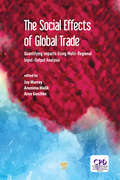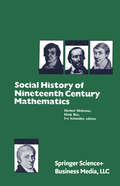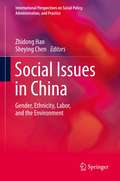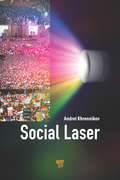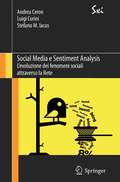- Table View
- List View
The Social Effects of Global Trade
by Joy Murray Arunima Malik Arne GeschkeThe inclusion of qualitative social data into global environmental and economic input-output (IO) models remained illusive for many years. It was not until around 2013 that researchers found ways to include data, for example, on poverty, inequality, and worker safety, into IO models capable of tracing global supply chains. The sustainable development goals have now propelled this work onto the world stage with some urgency. They have shone a spotlight onto social conditions around the world and brought global trade into the frame for its ability to influence social conditions for good or ill. This book provides a compilation of groundbreaking work on social indicators from the most prominent IO research groups from a wide range of academic backgrounds and from around the world. In addition, it frames this work in the real world of politics, human rights, and business, bringing together a multidisciplinary team to demonstrate the power of IO to illuminate some of the world’s most pressing problems. Edited by well-known researchers in the area, Joy Murray, Arunima Malik, and Arne Geschke, the book is designed to appeal to a broad academic and business audience. While many chapters include technical details and references for follow-up reading, it is possible to omit those sections and yet gain a deep appreciation of the power of IO to address seemingly intractable problems.
The Social Effects of Global Trade
by Joy Murray Arunima Malik Arne GeschkeThe inclusion of qualitative social data into global environmental and economic input-output (IO) models remained illusive for many years. It was not until around 2013 that researchers found ways to include data, for example, on poverty, inequality, and worker safety, into IO models capable of tracing global supply chains. The sustainable development goals have now propelled this work onto the world stage with some urgency. They have shone a spotlight onto social conditions around the world and brought global trade into the frame for its ability to influence social conditions for good or ill. This book provides a compilation of groundbreaking work on social indicators from the most prominent IO research groups from a wide range of academic backgrounds and from around the world. In addition, it frames this work in the real world of politics, human rights, and business, bringing together a multidisciplinary team to demonstrate the power of IO to illuminate some of the world’s most pressing problems. Edited by well-known researchers in the area, Joy Murray, Arunima Malik, and Arne Geschke, the book is designed to appeal to a broad academic and business audience. While many chapters include technical details and references for follow-up reading, it is possible to omit those sections and yet gain a deep appreciation of the power of IO to address seemingly intractable problems.
Social-Emotional Learning Through STEAM Projects, Grades 4-5
by Season MusseySocial-Emotional Learning Through STEAM Projects, Grades 4–5 helps educators target the development of social and emotional learning (SEL) competencies for high-ability learners through interdisciplinary, project-based inquiry. Aligned with STEAM content standards, each of the nine projects introduces students to a real-world problem through essential questions and the presentation of a primary source document. Both the content and the inquiry process support SEL competency development, from self-awareness to selfmanagement, social awareness, relationship skills, and responsible decision-making. As students work to understand and pose solutions to each problem, they gain the knowledge and practical skills needed to become more socially and emotionally competent individuals in their classroom communities.
Social-Emotional Learning Through STEAM Projects, Grades 4-5
by Season MusseySocial-Emotional Learning Through STEAM Projects, Grades 4–5 helps educators target the development of social and emotional learning (SEL) competencies for high-ability learners through interdisciplinary, project-based inquiry. Aligned with STEAM content standards, each of the nine projects introduces students to a real-world problem through essential questions and the presentation of a primary source document. Both the content and the inquiry process support SEL competency development, from self-awareness to selfmanagement, social awareness, relationship skills, and responsible decision-making. As students work to understand and pose solutions to each problem, they gain the knowledge and practical skills needed to become more socially and emotionally competent individuals in their classroom communities.
Social Exclusion in Later Life: Interdisciplinary and Policy Perspectives (International Perspectives on Aging #28)
by Kieran Walsh Thomas Scharf Sofie Van Regenmortel Anna WankaDrawing on interdisciplinary, cross-national perspectives, this open access book contributes to the development of a coherent scientific discourse on social exclusion of older people. The book considers five domains of exclusion (services; economic; social relations; civic and socio-cultural; and community and spatial domains), with three chapters dedicated to analysing different dimensions of each exclusion domain. The book also examines the interrelationships between different forms of exclusion, and how outcomes and processes of different kinds of exclusion can be related to one another. In doing so, major cross-cutting themes, such as rights and identity, inclusive service infrastructures, and displacement of marginalised older adult groups, are considered. Finally, in a series of chapters written by international policy stakeholders and policy researchers, the book analyses key policies relevant to social exclusion and older people, including debates linked to sustainable development, EU policy and social rights, welfare and pensions systems, and planning and development. The book’s approach helps to illuminate the comprehensive multidimensionality of social exclusion, and provides insight into the relative nature of disadvantage in later life. With 77 contributors working across 28 nations, the book presents a forward-looking research agenda for social exclusion amongst older people, and will be an important resource for students, researchers and policy stakeholders working on ageing.
Social History of Nineteenth Century Mathematics
by Mehrtens Hendrik (Short Hendriks Ivo SchneiderDuring the last few decades historians of science have shown a growing interest in science as a cultural activity and have regarded science more and more as part of the gene ral developments that have occurred in society. This trend has been less evident arnong historians of mathematics, who traditionally concentrate primarily on tracing the develop ment of mathematical knowledge itself. To some degree this restriction is connected with the special role of mathematics compared with the other sciences; mathematics typifies the most objective, most coercive type of knowledge, and there fore seems to be least affected by social influences. Nevertheless, biography, institutional history and his tory of national developments have long been elements in the historiography of mathematics. This interest in the social aspects of mathematics has widened recently through the stu dy of other themes, such as the relation of mathematics to the development of the educational system. Some scholars have begun to apply the methods of historical sociology of knowledge to mathematics; others have attempted to give a ix x Marxist analysis of the connection between mathematics and productive forces, and there have been philosophical studies about the communication processes involved in the production of mathematical knowledge. An interest in causal analyses of historical processes has led to the study of other factors influencing the development of mathematics, such as the f- mation of mathematical schools, the changes in the profes- onal situation of the mathematician and the general cultural milieu of the mathematical scientist.
Social Inequality in Japan (Nissan Institute/Routledge Japanese Studies)
by Sawako ShirahaseJapan was the first Asian country to become a mature industrial society, and throughout the 1970s and the 1980s, was viewed as an ‘all-middle-class society’. However since the 1990s there have been growing doubts as to the real degree of social equality in Japan, particularly in the context of dramatic demographic shifts as the population ages whilst fertility levels continue to fall. This book compares Japan with America, Britain, Italy, France, Germany, Sweden and Taiwan in order to determine whether inequality really is a social problem in Japan. With a focus on impact demographic shifts, Sawako Shirahase examines female labour market participation, income inequality among households with children, the state of the family, generational change, single person households and income distribution among the aged, and asks whether increasing inequality and is uniquely Japanese, or if it is a social problem common across all of the societies included in this study. Crucially, this book shows that Japan is distinctive not in terms of the degree of inequality in the society, but rather, in how acutely inequality is perceived. Further, the data shows that Japan differs from the other countries examined in terms of the gender gap in both the labour market and the family, and in inequality among single-person households – single men and women, including lifelong bachelors and spinsters – and also among single parent households, who pay a heavy price for having deviated from the expected pattern of life in Japan. Drawing on extensive empirical data, this book will be of great interest to students and scholars interested in Japanese culture and society, Japanese studies and social policy more generally.
Social Inequality in Japan (Nissan Institute/Routledge Japanese Studies)
by Sawako ShirahaseJapan was the first Asian country to become a mature industrial society, and throughout the 1970s and the 1980s, was viewed as an ‘all-middle-class society’. However since the 1990s there have been growing doubts as to the real degree of social equality in Japan, particularly in the context of dramatic demographic shifts as the population ages whilst fertility levels continue to fall. This book compares Japan with America, Britain, Italy, France, Germany, Sweden and Taiwan in order to determine whether inequality really is a social problem in Japan. With a focus on impact demographic shifts, Sawako Shirahase examines female labour market participation, income inequality among households with children, the state of the family, generational change, single person households and income distribution among the aged, and asks whether increasing inequality and is uniquely Japanese, or if it is a social problem common across all of the societies included in this study. Crucially, this book shows that Japan is distinctive not in terms of the degree of inequality in the society, but rather, in how acutely inequality is perceived. Further, the data shows that Japan differs from the other countries examined in terms of the gender gap in both the labour market and the family, and in inequality among single-person households – single men and women, including lifelong bachelors and spinsters – and also among single parent households, who pay a heavy price for having deviated from the expected pattern of life in Japan. Drawing on extensive empirical data, this book will be of great interest to students and scholars interested in Japanese culture and society, Japanese studies and social policy more generally.
Social Informatics: 8th International Conference, SocInfo 2016, Bellevue, WA, USA, November 11-14, 2016, Proceedings, Part I (Lecture Notes in Computer Science #10046)
by Emma Spiro and Yong-Yeol AhnThe two-volume set LNCS 10046 and 10047 constitutes the proceedings of the 8th International Conference on Social Informatics, SocInfo 2016, held in Bellevue, WA, USA, in November 2016. The 36 full papers and 39 poster papers presented in this volume were carefully reviewed and selected from 120 submissions. They are organized in topical sections named: networks, communities, and groups; politics, news, and events; markets, crowds, and consumers; and privacy, health, and well-being.
Social Informatics: 8th International Conference, SocInfo 2016, Bellevue, WA, USA, November 11-14, 2016, Proceedings, Part II (Lecture Notes in Computer Science #10047)
by Emma Spiro and Yong-Yeol AhnThe two-volume set LNCS 10046 and 10047 constitutes the proceedings of the 8th International Conference on Social Informatics, SocInfo 2016, held in Bellevue, WA, USA, in November 2016. The 33 full papers and 34 poster papers presented in this volume were carefully reviewed and selected from 120 submissions. They are organized in topical sections named: networks, communities, and groups; politics, news, and events; markets, crowds, and consumers; and privacy, health, and well-being.
Social Information Processing and Survey Methodology (Recent Research in Psychology)
by Hans-J. HipplerSurvey researchers have long been aware that the way in which questions are asked determines the obtained responses. However, the exact processes that mediate response effects remained elusive. In the present volume, cognitive psychologists and survey methodologists explore the cognitive processes that underlie respondents' answers to survey questions. The contributors provide an introduction to information processing theories for survey researchers, review current knowledge of response effects in the light of recent theorizing in cognitive psychology, and report a number of experimental studies on question context and question wording. In combination, the chapters provide a theoretical framework for the analysis of response effects in surveys and raise a number of applied and theoretical issues that have so far not been addressed in cognitive psychology.
Social Issues in China: Gender, Ethnicity, Labor, and the Environment (International Perspectives on Social Policy, Administration, and Practice #1)
by Zhidong Hao Sheying ChenSince 1978, the opening up and reform in China has brought tremendous economic and social changes. While China’s economic progress has been commendable, the social problems that go with economic changes have raised serious concerns. Some of those concerns are related to gender, ethnic, labor, and environmental issues. This book is about what has happened in these arenas in China since the opening up and reform in 1978. The study of gender, ethnicity, labor, and environment touches on some of the fundamental problems of modernization, especially the development of individuals and groups. So even though gender, ethnicity, labor, and environment seem to be separate issues, they are in fact related in some fundamental ways. That’s what this book will explore as well. To understand is one thing and to do is another. This book also incorporates studies of NGO practices to see how NGOs have helped in transforming gender, ethnic, labor, and environment interplay. Our study of NGOs in helping improve such interplay sheds light on how specifically civil society can prod the state to transform social relations for the better. This book is an attempt to assess the changes, both positive and negative, in gender, ethnic, ethnic, and environmental relations in China especially in the past 30 years of opening up and reform, especially regarding national identity formation.
Social Laser: Application of Quantum Information and Field Theories to Modeling of Social Processes
by Andrei KhrennikovThe recent years have been characterized by stormy social protests throughout the world. These protests have some commonalities, but at the same time, their sociopolitical, psychological, and economic contexts differ essentially. An important class of such protests is known as color revolutions. The analysis of these events in social and political literature is characterized by huge diversity of opinions. We remark that the sociopolitical perturbations under consideration are characterized by the cascade dynamics leading to the exponential amplification of coherent social actions. In quantum physics, such exponential and coherent amplification is the basic feature of laser’s functioning. (“Laser” is acronym for light amplification by stimulated emission of radiation). In this book we explore the theory of laser to model aforementioned waves of social protests, from color revolutions to Brexit and Trump’s election. We call such social processes Stimulated Amplification of Social Actions (SASA), but to keep closer to the analogy with physics we merely operate with the term “social laser.”
Social Laser: Application of Quantum Information and Field Theories to Modeling of Social Processes
by Andrei KhrennikovThe recent years have been characterized by stormy social protests throughout the world. These protests have some commonalities, but at the same time, their sociopolitical, psychological, and economic contexts differ essentially. An important class of such protests is known as color revolutions. The analysis of these events in social and political literature is characterized by huge diversity of opinions. We remark that the sociopolitical perturbations under consideration are characterized by the cascade dynamics leading to the exponential amplification of coherent social actions. In quantum physics, such exponential and coherent amplification is the basic feature of laser’s functioning. (“Laser” is acronym for light amplification by stimulated emission of radiation). In this book we explore the theory of laser to model aforementioned waves of social protests, from color revolutions to Brexit and Trump’s election. We call such social processes Stimulated Amplification of Social Actions (SASA), but to keep closer to the analogy with physics we merely operate with the term “social laser.”
Social Media Analysis for Event Detection (Lecture Notes in Social Networks)
by Tansel ÖzyerThis book includes chapters which discuss effective and efficient approaches in dealing with various aspects of social media analysis by using machine learning techniques from clustering to deep learning. A variety of theoretical aspects, application domains and case studies are covered to highlight how it is affordable to maximize the benefit of various applications from postings on social media platforms. Social media platforms have significantly influenced and reshaped various social aspects. They have set new means of communication and interaction between people, turning the whole world into a small village where people with internet connect can easily communicate without feeling any barriers. This has attracted the attention of researchers who have developed techniques and tools capable of studying various aspects of posts on social media platforms with main concentration on Twitter. This book addresses challenging applications in this dynamic domain where it is not possible to continue applying conventional techniques in studying social media postings. The content of this book helps the reader in developing own perspective about how to benefit from machine learning techniques in dealing with social media postings and how social media postings may directly influence various applications.
Social Media Communication Data for Recovery: Detecting Socio-Economic Activities Following a Disaster
by Yuya ShibuyaThis book explores the possibility of using social media data for detecting socio-economic recovery activities. In the last decade, there have been intensive research activities focusing on social media during and after disasters. This approach, which views people’s communication on social media as a sensor for real-time situations, has been widely adopted as the “people as sensor” approach. Furthermore, to improve recovery efforts after large-scale disasters, detecting communities’ real-time recovery situations is essential, since conventional socio-economic recovery indicators, such as governmental statistics, are not published in real time. Thanks to its timeliness, using social media data can fill the gap. Motivated by this possibility, this book especially focuses on the relationships between people’s communication on Twitter and Facebook pages, and socio-economic recovery activities as reflected in the used-car market data and the housing market data in the case of two major disasters: the Great East Japan Earthquake and Tsunami of 2011 and Hurricane Sandy in 2012. The book pursues an interdisciplinary approach, combining e.g. disaster recovery studies, crisis informatics, and economics. In terms of its contributions, firstly, the book sheds light on the “people as sensors” approach for detecting socio-economic recovery activities, which has not been thoroughly studied to date but has the potential to improve situation awareness during the recovery phase. Secondly, the book proposes new socio-economic recovery indicators: used-car market data and housing market data. Thirdly, in the context of using social media during the recovery phase, the results demonstrate the importance of distinguishing between social media data posted both by people who are at or near disaster-stricken areas and by those who are farther away.
Social Media e Sentiment Analysis: L'evoluzione dei fenomeni sociali attraverso la Rete (SxI - Springer for Innovation / SxI - Springer per l'Innovazione #9)
by Andrea Ceron Luigi Curini Stefano Maria IacusDue miliardi e mezzo di utenti internet, oltre un miliardo di account Facebook, 550 milioni di profili Twitter. Che parlano, discutono, si confrontano sui temi più svariati. Un flusso in continuo divenire di informazioni che dà sostanza ogni giorno al mondo dei Big Data. Ma come si analizza concretamente il “sentiment” della Rete? Quali sono i pregi e i limiti dei diversi metodi esistenti? E a quali domande possiamo dare una risposta? Dopo aver presentato le varie tecniche di analisi testuale applicate ai social media, questo libro discute di come l’informazione presente in Rete sia in grado di aiutarci a meglio comprendere il presente e a fare previsioni sul futuro riguardo a una molteplicità di fenomeni sociali, che spaziano dall’andamento dei mercati finanziari, alla diffusione di malattie, alle rivolte e ai sommovimenti popolari fino ai risultati dei talent show, prima di concentrarsi su due casi specifici: l’andamento della felicità degli italiani giorno per giorno, e i risultati delle campagne elettorali in Francia, Stati Uniti e Italia tra il 2012 e il 2013.
Social Media, Sociality, and Survey Research
by Craig A. Hill Elizabeth Dean Joe MurphyProvides the knowledge and tools needed for the future of survey research The survey research discipline faces unprecedented challenges, such as falling response rates, inadequate sampling frames, and antiquated approaches and tools. Addressing this changing landscape, Social Media, Sociality, and Survey Research introduces readers to a multitude of new techniques in data collection in one of the fastest developing areas of survey research. The book is organized around the central idea of a "sociality hierarchy" in social media interactions, comprised of three levels: broadcast, conversational, and community based. Social Media, Sociality, and Survey Research offers balanced coverage of the theory and practice of traditional survey research, while providing a conceptual framework for the opportunities social media platforms allow. Demonstrating varying perspectives and approaches to working with social media, the book features: New ways to approach data collection using platforms such as Facebook and Twitter Alternate methods for reaching out to interview subjects Design features that encourage participation with engaging, interactive surveys Social Media, Sociality, and Survey Research is an important resource for survey researchers, market researchers, and practitioners who collect and analyze data in order to identify trends and draw reliable conclusions in the areas of business, sociology, psychology, and population studies. The book is also a useful text for upper-undergraduate and graduate-level courses on survey methodology and market research.
Social Media, Sociality, and Survey Research
by Craig A. Hill Elizabeth Dean Joe MurphyProvides the knowledge and tools needed for the future of survey research The survey research discipline faces unprecedented challenges, such as falling response rates, inadequate sampling frames, and antiquated approaches and tools. Addressing this changing landscape, Social Media, Sociality, and Survey Research introduces readers to a multitude of new techniques in data collection in one of the fastest developing areas of survey research. The book is organized around the central idea of a "sociality hierarchy" in social media interactions, comprised of three levels: broadcast, conversational, and community based. Social Media, Sociality, and Survey Research offers balanced coverage of the theory and practice of traditional survey research, while providing a conceptual framework for the opportunities social media platforms allow. Demonstrating varying perspectives and approaches to working with social media, the book features: New ways to approach data collection using platforms such as Facebook and Twitter Alternate methods for reaching out to interview subjects Design features that encourage participation with engaging, interactive surveys Social Media, Sociality, and Survey Research is an important resource for survey researchers, market researchers, and practitioners who collect and analyze data in order to identify trends and draw reliable conclusions in the areas of business, sociology, psychology, and population studies. The book is also a useful text for upper-undergraduate and graduate-level courses on survey methodology and market research.
Social Mobility in the 20th Century: Class Mobility and Occupational Change in the United States and Germany
by Florian R. HertelBased on a novel class scheme and a unique compilation of German and American data, this book reveals that intergenerational class mobility increased over most of the past century. While country differences in intergenerational mobility are surprisingly small, gender, regional, racial and ethnic differences were initially large but declined over time. At the end of the 20th century, however, mobility prospects turned to the worse in both countries. In light of these findings, the book develops a narrative account of historical socio-political developments that are likely to have driven the basic resemblances across countries but also account for the initial decline and the more recent increase in intergenerational inequality.
Social Network Analysis Applied to Team Sports Analysis (SpringerBriefs in Applied Sciences and Technology)
by Filipe Manuel Clemente Fernando Manuel Martins Rui Sousa MendesExplaining how graph theory and social network analysis can be applied to team sports analysis, This book presents useful approaches, models and methods that can be used to characterise the overall properties of team networks and identify the prominence of each team player. Exploring the different possible network metrics that can be utilised in sports analysis, their possible applications and variances from situation to situation, the respective chapters present an array of illustrative case studies. Identifying the general concepts of social network analysis and network centrality metrics, readers are shown how to generate a methodological protocol for data collection. As such, the book provides a valuable resource for students of the sport sciences, sports engineering, applied computation and the social sciences.
Social Network Analysis - Community Detection and Evolution (Lecture Notes in Social Networks)
by Rokia Missaoui Idrissa SarrThis book is devoted to recent progress in social network analysis with a high focus on community detection and evolution. The eleven chapters cover the identification of cohesive groups, core components and key players either in static or dynamic networks of different kinds and levels of heterogeneity. Other important topics in social network analysis such as influential detection and maximization, information propagation, user behavior analysis, as well as network modeling and visualization are also presented. Many studies are validated through real social networks such as Twitter. This edited work will appeal to researchers, practitioners and students interested in the latest developments of social network analysis.
Social Network Analysis in Action: Basic Methods and Applications (Lecture Notes in Social Networks)
by Song YangThis book offers a balanced view between a basic introduction of Social Network Analysis (SNA) in its methods and application, and advanced topics of data mining techniques and the subsequent SNA analyses. The book stands out as uniquely important contribution to the SNA field because it moves beyond the stage of basic SNA methods. It describes data mining techniques, introducing an online discourse collection platform, ICAS, which is developed by an interdisciplinary team involving Sociologists and Computer Engineer teams with supports of NSF funds.Targeted audiences of this book are students and scholars interested in using SNA techniques to advance their analytics of their respective research areas. This book provides particular utilities to students at the beginner stage of learning SNA basics, and those in their intermediary careers looking to advance their knowledges of what SNA has to offer. The unique features of this book lie in its descriptions of data mining techniques, data processing, and data analytics. The discussions of an online discourse network platform and data processing capabilities present tremendous benefits to those who aspire to mine the massive data of online social networking.
Social Network-Based Recommender Systems
by Daniel SchallThis book introduces novel techniques and algorithms necessary to support the formation of social networks. Concepts such as link prediction, graph patterns, recommendation systems based on user reputation, strategic partner selection, collaborative systems and network formation based on ‘social brokers’ are presented. Chapters cover a wide range of models and algorithms, including graph models and a personalized PageRank model. Extensive experiments and scenarios using real world datasets from GitHub, Facebook, Twitter, Google Plus and the European Union ICT research collaborations serve to enhance reader understanding of the material with clear applications. Each chapter concludes with an analysis and detailed summary. Social Network-Based Recommender Systems is designed as a reference for professionals and researchers working in social network analysis and companies working on recommender systems. Advanced-level students studying computer science, statistics or mathematics will also find this books useful as a secondary text.
Social Network Forensics, Cyber Security, and Machine Learning (SpringerBriefs in Applied Sciences and Technology)
by P. Venkata Krishna Sasikumar Gurumoorthy Mohammad S. ObaidatThis book discusses the issues and challenges in Online Social Networks (OSNs). It highlights various aspects of OSNs consisting of novel social network strategies and the development of services using different computing models. Moreover, the book investigates how OSNs are impacted by cutting-edge innovations.
